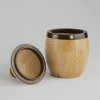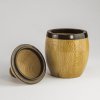Mark Hepburn
Artist & Chef
Okay,
So I'm trying to learn to take good photos and have invested in some low-end equipment for the sole purpose of photographing my work (which, at some point to be good enough to warrant the investment in camera, lights, etc. )
Having hijacked Gretch's post about fluorescent lighting, this is a continuation:
I'm using the following:
-Cowboy Studios 6 x 9 matte white vinyl background
-Softbox lights (18 x 24) on stands, with 550k CFL
-24" Etekcity reflector (white) with boom arm reflector stand
-Sony a3000 camera with the 18-55 lens it shipped with
-2 aluminum shop reflector lights (that I painted white with appliance epoxy) with 5000k CFL
Last from Bill:
I am using Adobe CC (man, I HATE subscription software and all the changes they've made to it) with the Raw input. So if I understand, I can set the camera for manual white balance each session (usually I'm only taking multiple shots of one item) by using a reference card?
I found several on Amazon that are highly rated and I assume that I'd go with a larger card rather than the pocket ones? I have a white vinyl photographer's backdrop for now, but there's a 3 card set (white, black, 18% gray). I was assuming that I'd use the white, but it seems that from the feedback (and some of it clearly from professionals also) that they use the grey card?
I also found the color checkers but is this something within the grasp of someone with ZERO photography training (which is something I plan on addressing with a class or clinic).
So to ask a bunch of questions about workflow, is this how I would proceed?
- set camera to manual white balance
- shoot the card (whichever one I should use?)
- take photos as usual
- bring in to Photoshop using Raw, adjust (using Auto?)
- open the image and tweak, crop, etc as normal
And as to shooting the card, assuming I want to fill the frame, do i put the card in the lit area and shoot it with the camera at the same distance as the subject would be, or closer?
I'm Googling some of this so I'm not expecting to be spoon fed, but it just isn't clicking for me.
Thanks, and especially to Bill (and John Lucas too).
And Bill, by the way, I went to look at your photos and they're so good. I really liked the cypress bowl in particular (bowl and photo). And the mesquite too.
Mark
So I'm trying to learn to take good photos and have invested in some low-end equipment for the sole purpose of photographing my work (which, at some point to be good enough to warrant the investment in camera, lights, etc. )
Having hijacked Gretch's post about fluorescent lighting, this is a continuation:
I'm using the following:
-Cowboy Studios 6 x 9 matte white vinyl background
-Softbox lights (18 x 24) on stands, with 550k CFL
-24" Etekcity reflector (white) with boom arm reflector stand
-Sony a3000 camera with the 18-55 lens it shipped with
-2 aluminum shop reflector lights (that I painted white with appliance epoxy) with 5000k CFL
Last from Bill:
Since you are shooting in raw, all that you need to do is to shoot a white balance target such as a Whi-Bal card to set the white balance for that particular shooting session and then use Adobe Camera Raw to set the white balance of all the images to match the setting of the reference shot1. All lighting changes continuously whether it is tungsten, fluorescent, LED, or flash. I have some 500 watt bulbs (4800K) that have a life of about six hours and I shoot a white balance reference shot every few minutes because the white balance actually changes that fast. It isn't necessary to create an in-camera custom white balance unless you want to get JPG images out of the camera. Certainly don't count on finding lighting that is going to precisely match any of the built-in white balance settings -- they are just ball park settings for those who want JPG out of the camera and don't want to mess with post processing.
Even better than shooting a white balance reference card is shooting a 24-patch Gretag-Macbeth target and creating a custom color profile if you want absolutely perfect color. X-rite sells a product called Color Checker Passport that includes the target plus software for automatically creating the profile. I think that it is pretty expensive, but I got it as part of a package that came with an i1 Display Pro calibrator.
I am using Adobe CC (man, I HATE subscription software and all the changes they've made to it) with the Raw input. So if I understand, I can set the camera for manual white balance each session (usually I'm only taking multiple shots of one item) by using a reference card?
I found several on Amazon that are highly rated and I assume that I'd go with a larger card rather than the pocket ones? I have a white vinyl photographer's backdrop for now, but there's a 3 card set (white, black, 18% gray). I was assuming that I'd use the white, but it seems that from the feedback (and some of it clearly from professionals also) that they use the grey card?
I also found the color checkers but is this something within the grasp of someone with ZERO photography training (which is something I plan on addressing with a class or clinic).
So to ask a bunch of questions about workflow, is this how I would proceed?
- set camera to manual white balance
- shoot the card (whichever one I should use?)
- take photos as usual
- bring in to Photoshop using Raw, adjust (using Auto?)
- open the image and tweak, crop, etc as normal
And as to shooting the card, assuming I want to fill the frame, do i put the card in the lit area and shoot it with the camera at the same distance as the subject would be, or closer?
I'm Googling some of this so I'm not expecting to be spoon fed, but it just isn't clicking for me.
Thanks, and especially to Bill (and John Lucas too).
And Bill, by the way, I went to look at your photos and they're so good. I really liked the cypress bowl in particular (bowl and photo). And the mesquite too.
Mark














